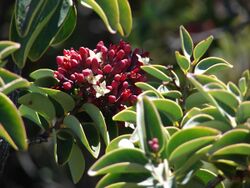Biology:Santalum haleakalae
| Santalum haleakalae | |
|---|---|

| |
| Scientific classification | |
| Kingdom: | Plantae |
| Clade: | Tracheophytes |
| Clade: | Angiosperms |
| Clade: | Eudicots |
| Order: | Santalales |
| Family: | Santalaceae |
| Genus: | Santalum |
| Species: | S. haleakalae
|
| Binomial name | |
| Santalum haleakalae Hillebr.[2]
| |
Santalum haleakalae, known as Haleakala sandalwood[3] or ʻIliahi in Hawaiian, is a species of flowering tree in the sandalwood family, that is endemic to the islands of Maui, Lanai, and Molokai in the Hawaiian Islands, part of the United States .[4][5] It grows in subalpine shrublands at elevations of 1,900 to 2,700 m (6,200 to 8,900 ft), especially on the slopes of Haleakalā.[6]
Description
This is a shrub or small tree with green, ovate leaves that are often glaucous and tinged purple, especially in var. halekalae.[6] The flowers are cream-colored to red in bud and cream to white when open, arranged in tight compound cymes.[6] The fruit are reddish to black drupes.[6]
Range
Santalum haleakalae var. haleakalae occurs only on the slopes of Haleakalā on Maui.[5] Santalum haleakalae var. lanaiense occurs on the islands of Lanai, Molokai, and Maui.[4]
Habitat
Santalum haleakalae var. haleakalae occupies subalpine and montane mesic forests,[5] while Santalum haleakalae var. lanaiense occupies wet shrublands.[4][6]
Ecology
Like most sandalwoods, Santalum haleakalae is a hemiparasite, deriving some of its nutrition from the roots of surrounding plants, and Santalum haleakalae var. lanaiense is thought to use koa (Acacia koa) as a host (among other native trees).[4] Their flowers provide nectar for native Hawaiian honeycreepers like the Maui ʻamakihi.[7]
Human use
Native Hawaiians used ‘iliahi (including other native members of this genus) for a variety of medicinal purposes, perfuming kapa, and making musical instruments.[8] After learning of the lucrative global market in sandalwood in the late 18th century, Hawaiian nobles forced people of lower castes to harvest the wood of this and related trees, many of whom suffered or died in the process, resulting in famine due to abandoning food crops. Hawaii was so well known in China for its sandalwood that people in the Macau area referred to it as "Tan Heung Shan," or "the Sandalwood Mountains."[9] The trade in Hawaiian sandalwood ended around the middle of the 19th century, and while many ‘iliahi populations have recovered, large, old trees remain difficult to find.[10]
Etymology
The specific and varietal epithet haleakalae comes from Haleakalā, the volcano to which that variety is endemic.[10] The varietal epithet lanaiense comes from the island of Lanai, one of the islands where that variety occurs.[11]
Taxonomy
Research in 2010 determined that the Santalum freycinetianum was polyphyletic and the variety Santalum freycinetianum var. lanaiense was most closely related to S. haleakalae. The authors combined them as two varieties of the same species, Santalum haleakalae var. haleakalae for the plants on Haleakalā and Santalum haleakalae var. lanaiense for the plants elsewhere on Maui as well as on Lanai and Molokai.[12]
References
- ↑ World Conservation Monitoring Centre 1998. Santalum haleakalae. 2006 IUCN Red List of Threatened Species. Downloaded on 23 August 2007.
- ↑ {{citation | mode = cs1 | title = Santalum haleakalae | work = Germplasm Resources Information Network (GRIN) | url = | publisher = [[Organization:Agricultural Research ServAgricultural Research Service (ARS), United States Department of Agriculture (USDA) | access-date = 2011-03-08 }}
- ↑ "Santalum haleakalae". Natural Resources Conservation Service PLANTS Database. USDA. https://plants.usda.gov/core/profile?symbol=SAHA3. Retrieved 5 November 2015.
- ↑ 4.0 4.1 4.2 4.3 Khan, Nancy. "Santalum haleakalae var. lanaiense". Smithsonian Institution. https://naturalhistory2.si.edu/botany/hawaiianflora/speciesdescr.cfm?genus=Santalum&species=haleakalae&rank1=var.&epithet1=lanaiense.
- ↑ 5.0 5.1 5.2 Khan, Nancy. "Santalum haleakalae var. haleakalae". Smithsonian Institution. https://naturalhistory2.si.edu/botany/hawaiianflora/speciesdescr.cfm?genus=Santalum&species=haleakalae&rank1=var.&epithet1=haleakalae.
- ↑ 6.0 6.1 6.2 6.3 6.4 Merlin, Mark D; Lex A.J. Thomson (April 2006). "Santalum ellipticum, S. freycinetianum, S. haleakalae, and S. paniculatum (Hawaiian sandalwood)". Species Profiles for Pacific Island Agroforestry. Agroforestry Net, Inc. http://www.agroforestry.net/tti/Santalum-Haw-sandalwood.pdf.
- ↑ cmario (August 2019). "Maui ʻAmakihi (Subspecies Chlorodrepanis virens wilsoni)" (in en). https://www.inaturalist.org/observations/31710655.
- ↑ "Bishop Museum - Ethnobotany Database". Bishop Museum. http://data.bishopmuseum.org/ethnobotanydb/ethnobotany.php?b=d&ID=iliahi.
- ↑ Char, Tin-yuke (1976). "A Hawaiian King Visits Hong Kong, 1881". Journal of the Hong Kong Branch of the Royal Asiatic Society 16: 92–106. ISSN 0085-5774. https://www.jstor.org/stable/23886747. Retrieved 12 December 2021.
- ↑ 10.0 10.1 Elliott, Daniela Dutra; Tamashiro, Shari Y.. "Native Plants Hawaii - Viewing Plant : Santalum haleakalae var. haleakalae". University of Hawaii. http://www.nativeplants.hawaii.edu/plant/view/Santalum_haleakalae_haleakalae.
- ↑ Elliott, Daniela Dutra; Tamashiro, Shari Y.. "Native Plants Hawaii - Viewing Plant : Santalum haleakalae var. lanaiense". University of Hawaii. http://www.nativeplants.hawaii.edu/plant/view/Santalum_haleakalae_lanaiense.
- ↑ Harbaugh, Danica T.; Oppenheimer, Hank L.; Wood, Kenneth R.; Wagner, Warren L. (1 December 2010). "Taxonomic Revision of the Endangered Hawaiian Red-flowered Sandalwoods (Santalum) and Discovery of an Ancient Hybrid Species". Systematic Botany 35 (4): 827–838. doi:10.1600/036364410X539899. https://www.ingentaconnect.com/content/aspt/sb/2010/00000035/00000004/art00013.
External links
- "Sandalwood trade". Hawaiʻi History Library. HawaiiHistory.org. http://www.hawaiihistory.org/index.cfm?fuseaction=ig.page&PageID=274.
- "iliahi". Hawaiian Ethnobotany Online Database. Bernice P. Bishop Museum. http://www2.bishopmuseum.org/ethnobotanydb/resultsdetailed.asp?search=iliahi.
Wikidata ☰ Q5464147 entry
 |


